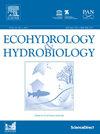城市富营养化湖泊中水生植物根瘤菌的丰度和群落结构
IF 2.2
4区 环境科学与生态学
Q2 ECOLOGY
引用次数: 0
摘要
与氨氧化古细菌和氨氧化细菌不同,完全氨氧化细菌可直接将氨氧化为硝酸盐。因此,有必要明确氨氧化细菌在水体中的分布情况。水生植物的根系能为硝化作用提供有利条件,因此经常被用来修复受污染的湖泊。本研究调查了城市富营养化湖泊月湖中四种水生植物根圈中兼氧菌的群落结构。结果表明,大多数水生植物近根瘤菌的丰度高于远根瘤菌,表明水生植物促进了富营养化湖泊中根瘤菌的丰度。comammox 细菌的 A 支系和 B 支系均存在于月湖中,前者占优势。共现网络分析显示,支系A的两个亚支系在近根圈和远根圈的网络参数相反。冗余分析(RDA)分析表明,OM、pH 和沉积物的 NON 与 comammox 细菌的丰度相关,是影响该微生物生长的主要环境因素。这些结果表明,水生植物影响了沉积物中comammox细菌的分布和多样性,从而可能导致氨氧化过程的变化和水体富营养化。本文章由计算机程序翻译,如有差异,请以英文原文为准。
Abundance and community structure of comammox bacteria in the rhizosphere of aquatic plants in an urban eutrophic lake
Different from ammonia oxidizing archaea and ammonia oxidizing bacteria, complete ammonia oxidation (comammox) bacteria can directly oxidize ammonia to nitrate. Hence, it is necessary to clarify the distribution of comammox bacteria in water bodies. Aquatic plants, whose roots can provide favorable conditions for nitrification, are often used to remediate polluted lakes. This study investigated the community structure of comammox bacteria in the rhizosphere of four aquatic plants in Lake Yuehu, an urban eutrophic lake. The results showed that the abundance of comammox bacteria in the near-rhizosphere of most aquatic plants was higher than that in the far-rhizosphere, suggesting that the aquatic plants promote the rhizosphere abundance of comammox bacteria in eutrophic lakes. Both clade A and clade B of comammox bacteria were present in the Lake Yuehu, with the former showing greater dominance. Co-occurrence network analysis revealed that two subclades of clade A had opposite network parameters in the near-rhizosphere and far-rhizosphere. Redundancy analysis (RDA) analysis showed that OM, pH and NO2--N of sediment were correlated with the abundance of comammox bacteria, which were the main environmental factors affecting the growth of this microorganism. These results suggest that aquatic plants affected the distribution and diversity of comammox bacteria in sediments, which may result in changes in the process of ammonia oxidation and eutrophication in water.
求助全文
通过发布文献求助,成功后即可免费获取论文全文。
去求助
来源期刊

Ecohydrology & Hydrobiology
Agricultural and Biological Sciences-Aquatic Science
CiteScore
5.40
自引率
3.80%
发文量
51
期刊介绍:
Ecohydrology & Hydrobiology is an international journal that aims to advance ecohydrology as the study of the interplay between ecological and hydrological processes from molecular to river basin scales, and to promote its implementation as an integrative management tool to harmonize societal needs with biosphere potential.
 求助内容:
求助内容: 应助结果提醒方式:
应助结果提醒方式:


